I had been distracted for a couple weeks by the prospects of wing foiling when I received a fortuitous email from France. The wing was invading my Instagram feed and it seemed like a viable alternative to outer swell tow-in sessions with a boat (a cure for harbor parking fees, purchasing fuel and taking non-foiling turns behind the wheel). The F-One team was headed to Madagascar to shoot their 2020 marketing images and they wanted to get some perspective from kite media on their new wing surfing product. There’s quite a bit of skepticism out there, including hilarious memes about umbrella foiling and inflatable fruit strapped to your back foiling, but despite the ridicule and doubt, wing surfing’s seductive promise of surfing waves in a new way was triggering my Pavlovian response so flying 30-hours half-way around the world to try my hand at F-One’s wing surfing product seemed perfectly rational.
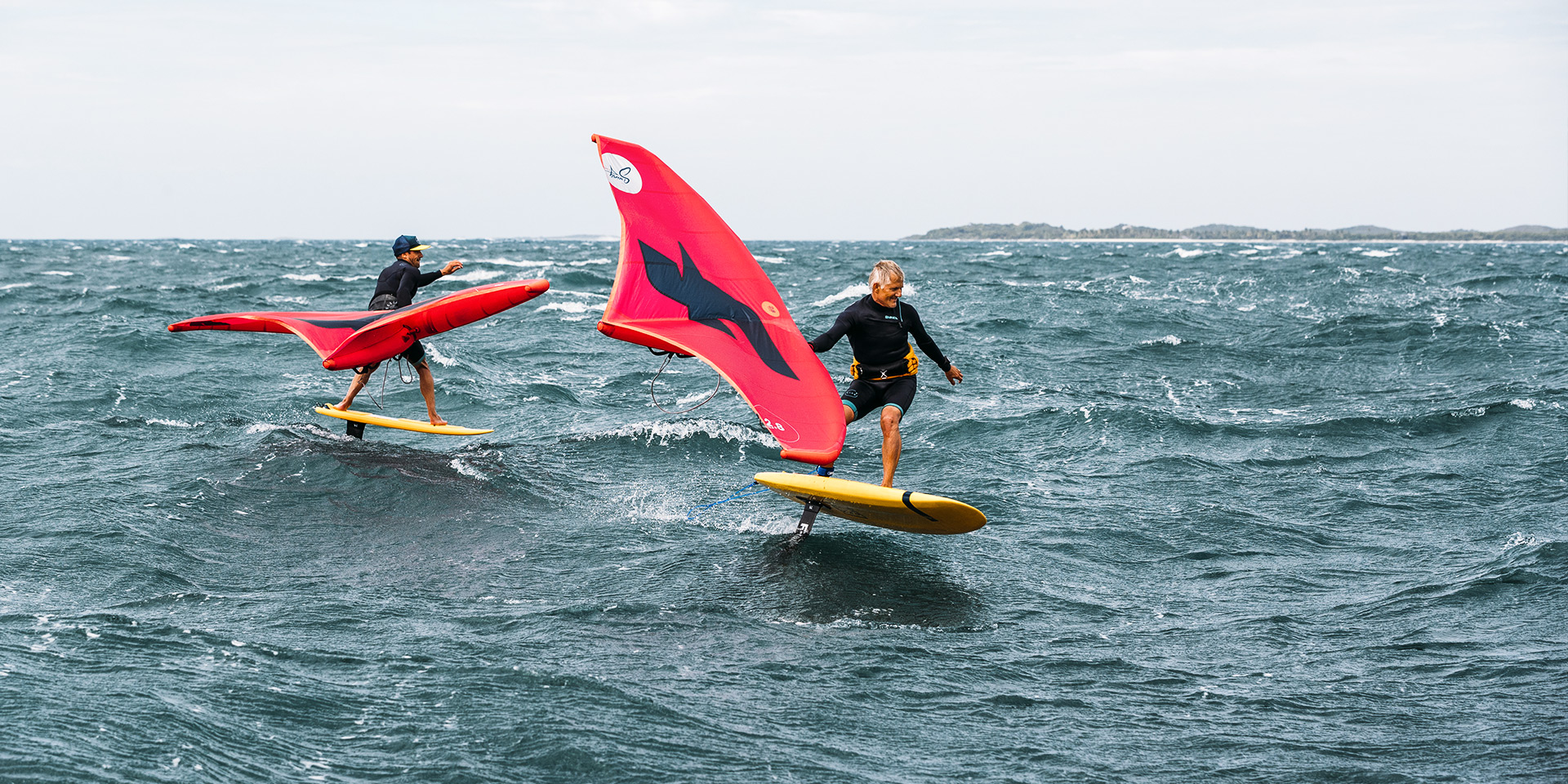
F-One owner Raphael Salles followed by R&D tester Micka Fernandez making use of the wind swell in the outer waters of northern Madagascar at the 2020 photo shoot. // Photo Ydwer.com
In my small world, I assume all kitesurfers are like me, driven by the same appetite for wind and waves, but I forget that is not always the case. If you are a foil racer, a freeride big air hucker or freestyle specialist, I don’t blame you for your skepticism. However, the reason the wing is on a pedestal for myself and other obsessed foil surfing watermen around the world is because it teases the promise of foil surfing swell in ways you can’t do with a kite, a SUP paddle, and certainly not with jet ski tow-ins or a windsurfing sail. The advantage of the wing is that it delivers endless and on-demand power to swing you into swell and then practically disappears, hovering by your side as you carve up the open face the way you want, not the way a kite demands.
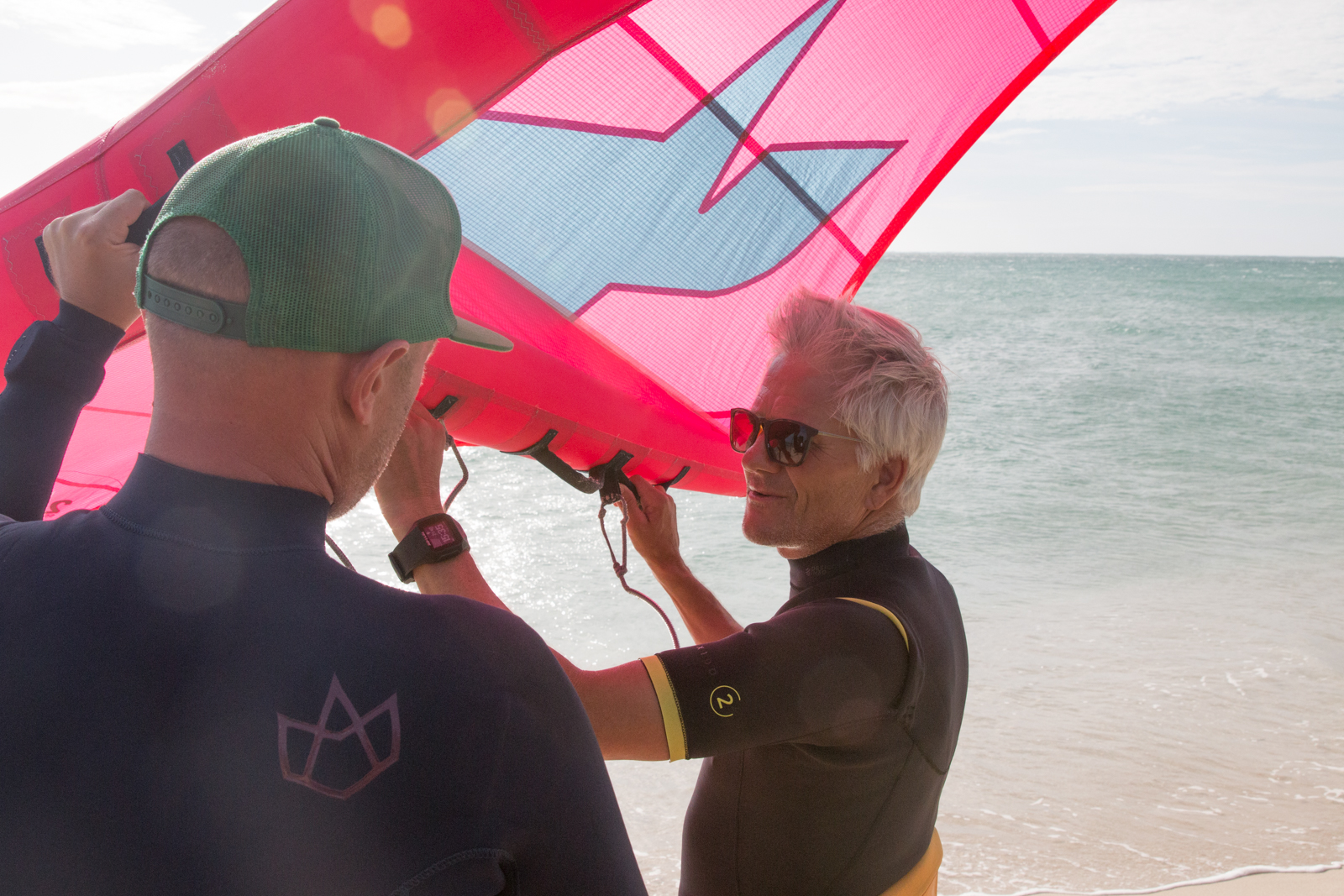
Professor Salles gives a 5-minute lecture on wing surfing basics to IKSURF magazine editor, Rou Chater. Having taught himself with prototypes, Raphael has paid more than his fair share of dues. // Photo Tkb Magazine
When I landed in Madagascar it was clear that the wing frenzy was thriving within the F-One surf team. Surrounded by shallow lagoons, my first attempt had to wait for a couple of days for when we could take a boat to water deep enough to ride a foil. My kite wing initiation started in a choppy lagoon with about 30 knots of wind bending around an offshore island. I was given a short list of instructional tips by French waterman and owner of F-One, Raphael Salles, all of which I gladly accepted.
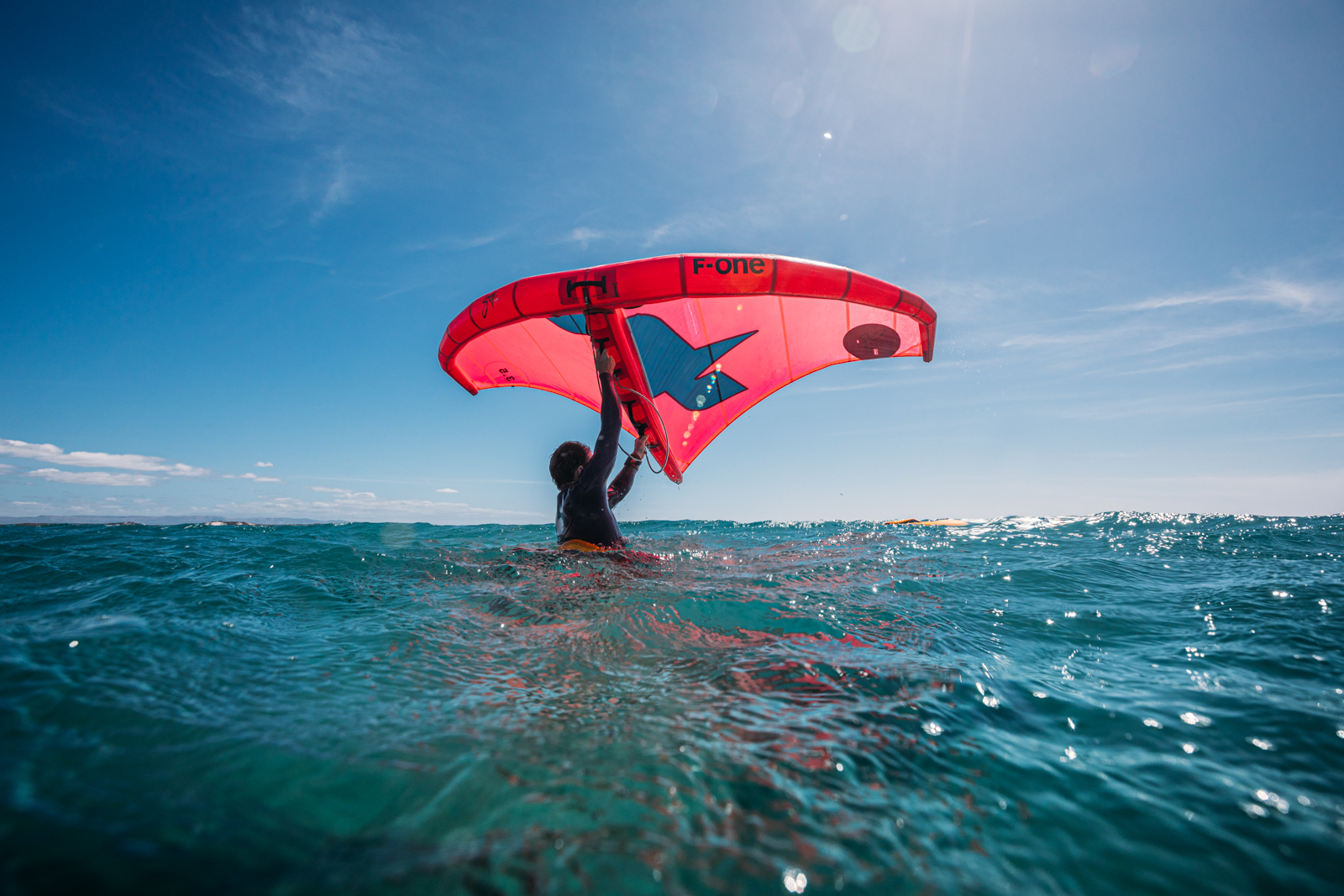
On the second session, Tkb’s Editor ditches the foilboard leash and learns to use the wing to chase after a drifting foilboard. As it turns out, having a leash on the wing is essential. // Photo Ydwer.com
Top on the list of things to consider was how to hold the wing in pre-start mode, how to kneel on the SUP in a slightly diagonal fashion to balance side to side and forward and aft, and probably most importantly, how to hold the wing higher/more vertical in the wind window. As I would find out, that last tip was the most crucial to getting past wing foiling’s first and most common self-defeating mistake dragging the lower wingtip in the water. As I would soon learn, when the wingtip hits the water, the party is over, the extra drag ends up backwinding the wing, flipping it upside down and forces you to start all over again.

Volume is your friend for your first water starts. IKSURF magazine editor, Rou Chater demonstrating the diagonal kneeling water start method on a 6’3″ 90 liter SUP foil. // Photo Tkb Magazine
My first session I started with the 3.5m wing in about 25 knots of wind. I was riding a 6’3” foil SUP with 90 liters of buoyancy and F-One’s largest 1800 SUP foil wing, which meant the board was floating above water when I was standing on it with a fair amount of stability. Right off the bat, I was spending about 50% of my time riding, 30% water starting, and another 20% flailing in the water trying to flip an upside-down wing right side up.

Tkb’s Editor up and riding, focusing on keeping the wing higher in the wind window and the wingtip from dragging in the water while showing poor windsurfing form with bent elbows. // Photo Ydwer.com
When exhaustion and frustration begin to ramp up, I take a deep breath and go back to the basics my biggest problem while riding is that the wingtip keeps scraping the water, then flipping the wing upside down, pulling me off foil and crashing with the wing flailing off-axis. I take a moment to relax, a long breath, and let the frantic adrenaline subside while I vow to re-focus my riding attention on holding the wing higher over my head. This simple trick solves my biggest problem and yields my biggest epiphone The wing is actually a kite it can be sheeted in and out like a kite, but more important and less obvious, it must be steered through a wind window like a kite. Since the wing is not attached to the board like a windsurfing sail, it has a wind window and you use your front and back hands to steer the wing horizontally or vertically. Contrary to the bicycle/pivot steering of kiteboarding, you drive the wing like a car, rotating your hands in a circle. When the wing gets too low, and the wingtip is in danger of dragging, you rotate your back hand down towards the water, your forward hand up towards the sky and the wing climbs higher in your wind window. There’s a lot of tricks to the water start, pumping up on to foil, trimming the wing for power or depower, but the concept of steering the wing is the one that accelerates my learning curve the most.
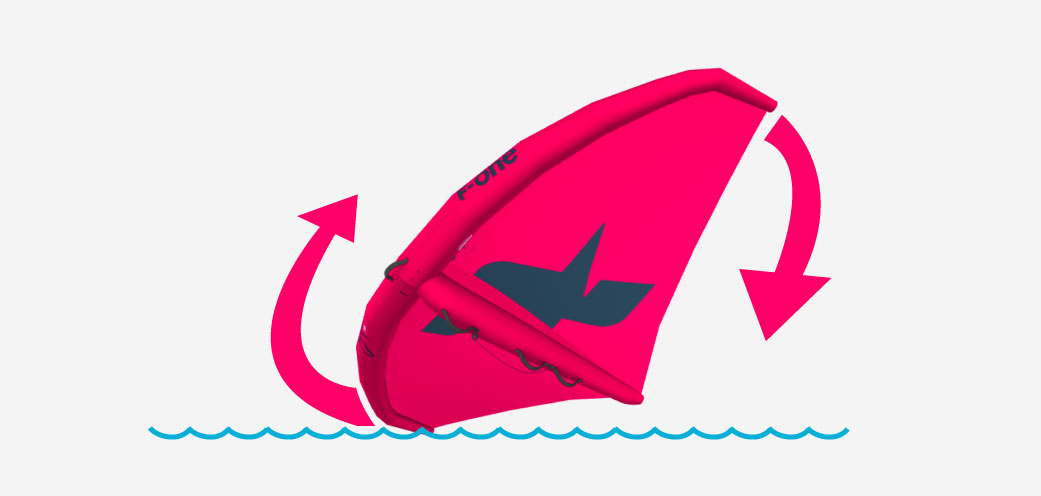
The epiphone: Since the wing is not attached to your board, it has a wind window and you have to actively steer with your hands on the boom to keep the wingtips from making contact with the water.
During my first 30-minute session I attain the holy grail, riding back and forth and staying upwind while successfully returning to the beach without need of rescue. For my second 30-minute session I move down to a 5’10” 80-liter board, which means the board sinks to about even with the water when I’m standing on it, but it is still stable and easy to stand up and then accelerate the board onto plane. I begin hooking my harness into the harness line attached to the inflatable boom (F-One seems to be one of the few companies that have this harness line feature). This transfers all the pull of the wing to my harness and my hands learn to relax and trim the wing which makes going upwind easier. A lot of the muscle memory feels reminiscent of my windsurfing days and this is probably why my learning curve seems quick and relatively painless. On one hand, the simplicity of wing surfing without a harness and the harness lines is seductive and super clean, but for the longevity of my earlier sessions, the harness line is key for keeping me on the water longer.
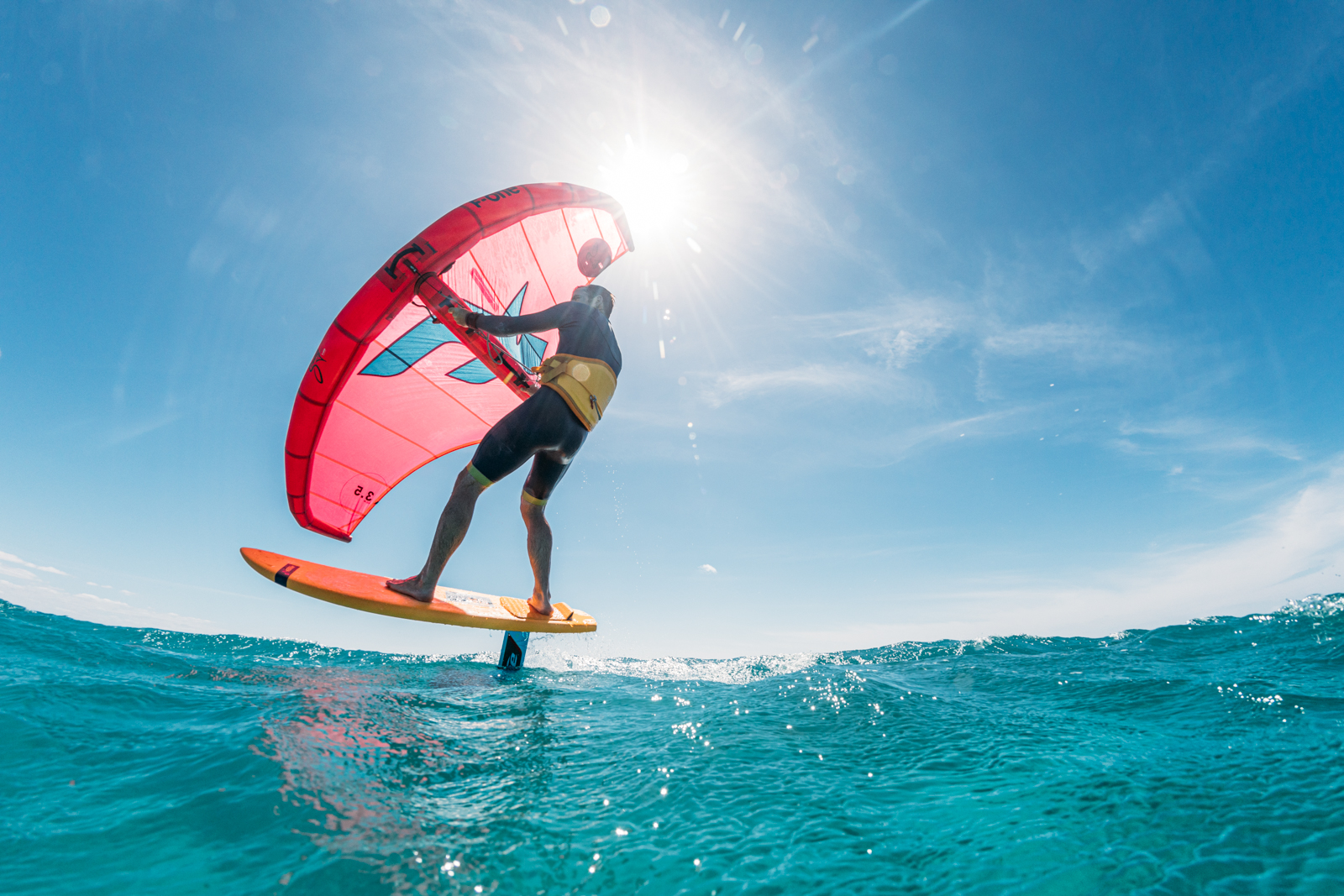
Using a harness to hook into the boom’s harness line removes load from your arms and shoulders and allows you to loosen your grip and conserve energy on upwind legs. // Photo Ydwer.com
For my third session, I try water starting a 5’0” 35.5-liter prone foilsurfing board. Miraculously, I nail the first water start but then flai on the next couple before getting the process down. The key is sinking the board while setting your feet with your front hand planted on the downwind rail towards the nose. Underwater, my legs are in a full squat to keep the board as close to the surface as possible. Using my hand on the rail to control the board and my back hand on the forward boom handle, I lean against the buoyant wing’s boom to steady me in the chop. When I’m ready, my front hand comes off the board’s rail, my back hand passes the front boom handle to my front hand and my back hand then grabs the back boom handle and I begin pumping the wing directly overhead to bring my body weight out of the water. As my torso rises out of the water I let the nose of the board point up a bit so the board wants to come up with me. I tilt the wing in the forward direction to create some forward pressure on the board and once the board is at the surface of the water, I begin pumping the board’s foil wing to separate the board from the water’s friction and accelerate on to foil.

Pumping across the small wind swell inside the lagoon, Tkb’s Editor learns to hold the wing on the LE handle to put the wing in hover mode and throw corny shakas to the camera. // Photo Ydwer.com
Transitioning to the smaller board makes a huge difference; everything happens faster and turning down wind and pumping across small wind chop becomes much easier with the small deck. It becomes natural to have the wing hovering, waiting for the moment when I need wind power. Gybes get significantly more difficult on the smaller board, footwork swaps have to be faster and more instantaneous. My footwork is slower and much uglier than kite foiling due to so much of my focus being on the wing and the lack of upward vector you get from a kite. At the same time, the muscle memory for the wing’s behavior begins to build and my hands begin to seamlessly pass the wing back and forth, transitioning through water starts, gybes and hover mode more effortlessly and with far less mental concentration.
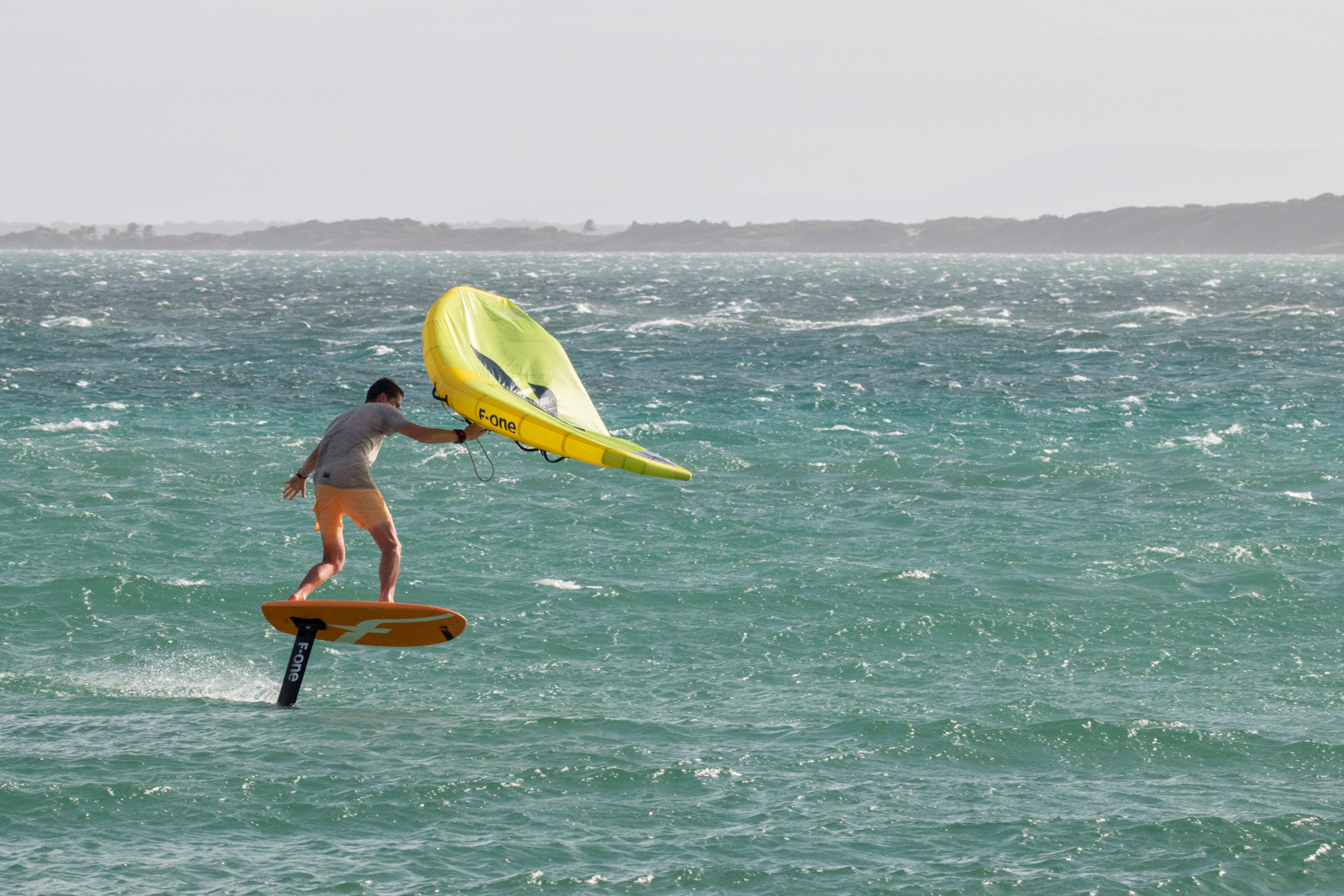
F-One team rider, Tituoan Galea, carving up the short interval chop inside the lagoon sans harness. Titu pioneered wing surfing jumps while we were in Madagascar, yet his “first big air on Instagram” claim was stolen out from underneath him within a matter of hours. // Photo Tkb Magazine
The highlight of wing foiling came at the end of my third session when I follow Raphael, Micka Fernandez (F-One’s R&D tester) and team rider Tituoan Galea out of the lagoon, through a small reef pass into the deep water just beyond the outer reefs. With about a mile downwind run, I watch as they hooked into shoulder high rollers, playing on the edge of the reef, crossing tacks and carving freely through the waist high wind swell.
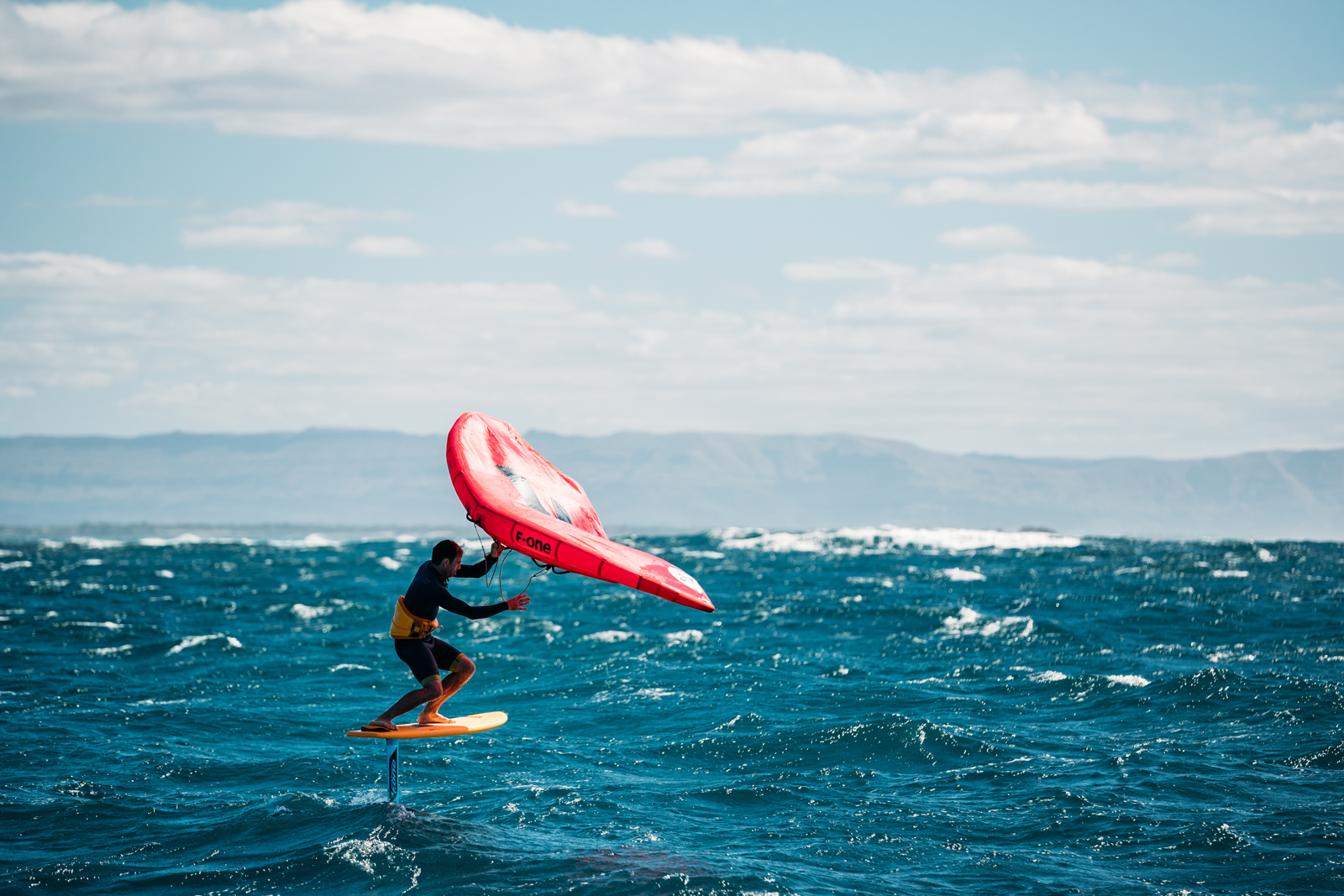
Graduating to the outer reefs where the wind swell is larger, Tkb’s Editor focuses on lining up rides and minimizing water starts while enjoying the umbrella-like sun shade of the wing. // Photo Ydwer.com
I learn very quickly to stay away from the edge of the reef where the others are confidently riding. At this point I have about 15 successful low volume/sinking water starts under my belt and in the large rollers my confidence in each step is waning; sinking the board, hovering neck deep and using the wing to get the board back up to the surface. When I am up and riding, the depower of the wing is huge in the outer swells, seamlessly powering up and letting go as the wing engages with slope energy. Raphael kept calling it “down-winding for kooks,” laughingly over the nighttime dinner table. What I think he meant is that most forms of down-winding such as SUP paddling and SUP foiling are much harder than they look yet for Raphael, wing surfing is hands down the easiest and most fun form of down-winding, and I agree. I spend the entire time on those outer reefs carving and gliding from wave to wave, using the combination of the wing and board pumping to transfer to the next swell.
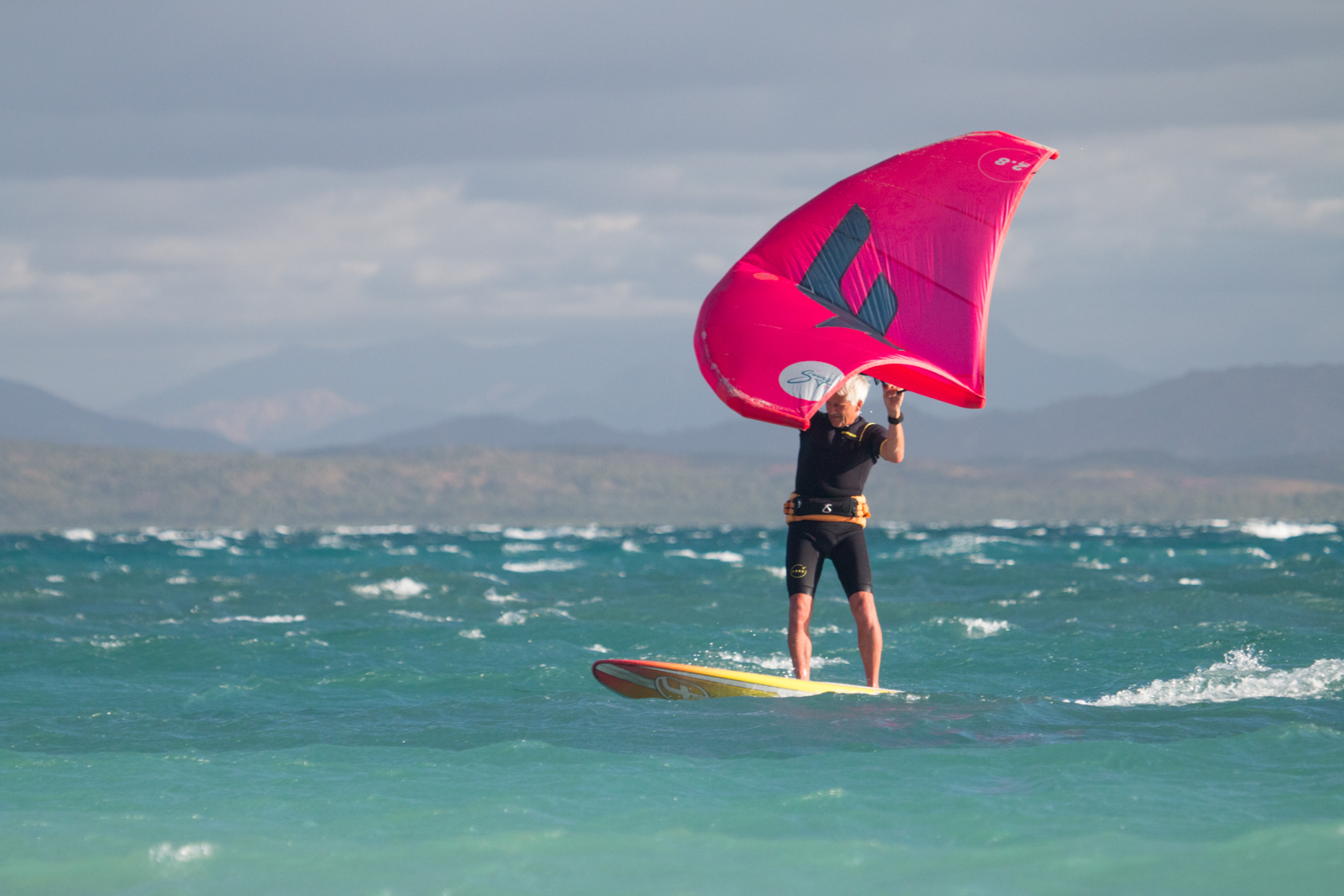
Raphael testing the wing’s utility for SUP surfboard cruising. The early consensus is that strong wind and chop is probably not the ideal setup for longboard wing surfing. // Photo Tkb Magazine
At the end of the outer reef run, we have to turn the corner and wing our way back upwind to our home island. It’s at this point that I learn the biggest downside to wing surfing on low volume boards. Wind strength is incredibly important when riding low volume sinker boards. Without the flotation, you have to use the sheer power of the wing to bring your body weight and the board out of the water. Once the board has been brought up to the surface, pumping the board is enough to release surface tension and achieve foil up speed, but if the wind drops below a threshold for your wing size, the wing can’t lift your body weight, and in that scenario, you end up submerged at chest level, balancing your board underneath you, eagerly waiting for the next gust. I was lucky, I always found that next gust and made it back up wind, but with that in mind I think for those first sinker sessions you really need a solid bail-out plan-B, or a good rescue option.
Another aspect of wing foiling that surprised me is the upwind angle. Since kite foiling offers a really high upwind trajectory I expected the same for wing foiling, but it seems the wing angle is more on par with twin tip riding. I suppose you could call the upwind angle a downside (what does that say about twin tip kiteboarding?), but for me, it just means that I have to do longer tacks upwind to offset my downwind hover mode carving.
Prior to trying wing foiling, I had read that of the many armchair complaints by kiteboarders. A big downside was that the wing gets in the way of your visual sight lines. This is somewhat true when going up wind, yet I found most of my attention was looking forward to navigate the foil through the chop. When I was carving downwind, the wing wasn’t in the way and this seemed to be when visual sight really mattered. The most salient thing I discovered about the wing was that it served as excellent sun protection on upwind slogs; as the week wore on I found periodic shady breaks were greatly welcomed in the equatorial sun.
Perhaps the final and most important take-way from my trip to Madagascar with the F-One team would be to select your board size wisely. We were wing foiling most days in 6m-8m kite conditions, swapping between 2.8m and 3.5m wings and while technique and board size are huge factors in determining the threshold for water starts, in general, I believe wing foiling is probably ideal in 18knots and up (I could be wrong because with it blowing 20+ everyday in Madagascar there was no chance to explore threshold conditions). Ultimately, I encourage everyone to consider an appropriate board volume for their skill level and their site setup. I was in a race to see how low volume I could go, but I was also surrounded by the F-One safety net. If I were on my own, I would choose a higher volume board to maximize the range of conditions I could water start and go upwind in, giving me a bigger safety buffer.

F-One team rider Tituoan Galea transferring his kite foil racing background into hard carving wing surfing skills. // Photo Ydwer.com
As guinea pig 1.0, I think my learning curve speaks volumes to the validity of this new sport. Athletes will pick it up extremely fast, weekend warriors might flail for a couple of hours on an appropriately sized board, but much like kitesurfing, the learning curve accelerates once you get past the basic building blocks. If you have foilboarding skills and you spend your foil time trying to hunt downwind swell energy, then F-One (and most other kite brands) has a new sport for you. As an open-minded kitesurfing magazine editor with a windsurfing background and current addiction to anything foilsurfing, perhaps I’m an easy convert, yet by the end of the week I watched most of the F-One freestyle team (the guys with boots and wakeboards) excitedly line up to try and succeed at wing surfing in their free time. If the skeptics are labeling wing foiling as the latest fad, I’d like to say think again. When kitesurfing first showed up it quickly divided the early adopters from the holdouts, but in the end, it converted a lot of people and evolved into something that few could imagine in the early days. Call me optimistic, although the audience for wing surfing may perhaps be narrower than kitesurfing, in my personal opinion, it’s going to be just another must-have arrow in the quiver that has its time and place in the dedicated waterman’s arsenal.

